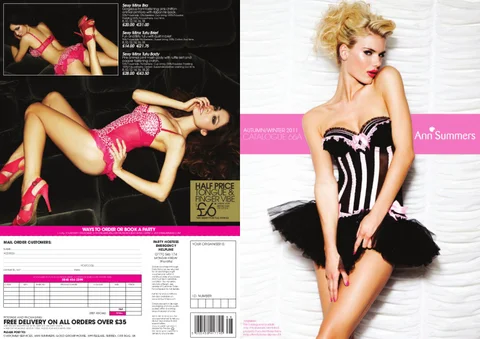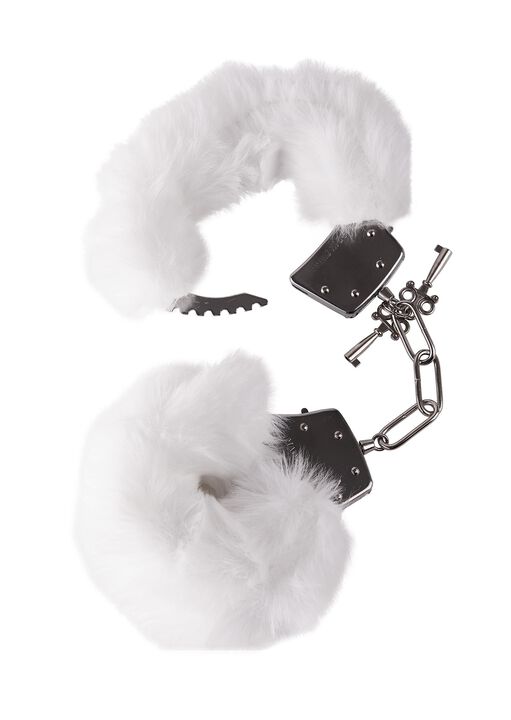Storr, Merl. 2003. Latex and Lingerie : Shopping for Pleasure at Ann Summers. Oxford: Berg. Amazon

Ann Summers is a UK brand of lingerie and sex toys, sold by brick-and-mortar stores, by online retailing and by a system of “Ann Summers parties”, in which saleswomen organize parties and directly market goods to the (all female) attendees. These goods include lingerie, sex toys, and related items. In particular, they sell bondage cuffs, light impact implements and other BDSM equipment. The Ann Summers parties are a point where “the rubber meets the road”, where people (i.e. hetero, vanilla women) have their first direct contact with BDSM toys, and the concept of BDSM play in general. Merl Storr’s book, based on interviews with party hosts and participant observation, presents valuable insights into how vanilla/hetero identities can change to accommodate the purchase of BDSM gear, if not the actual use of such.
Ann Summers parties depended on two psychological/social dynamics to make their sales.
The first is group homosociality. Ann Summers goods are somewhat taboo, first for being presented as sexual, second for being luxury items. The parties organized by the company’s representatives put the women in domestic, group settings, with food, drink and games, all to build group identity, lower inhibitions and shift responsibility for taboo-breaking to the collective. If the customer thinks of herself as “one of the girls”, and the other girls are making purchases, they are more likely to make the purchases too.
The second is aspirational purchasing. Ann Summers, as a brand, targets working class and lower-middle-class women with limited disposable income. Their products have to be glamorous, luxurious and pleasurable, yet affordable and useful. If the sales person fails to strike this balance, an item may be refused for being too “tacky” (affordable yet lacking the quality expected, making it associated with lower-class female sexuality), or for being too “high class” (lacking the utility for the money, making it frivolous and therefore wasteful). [Pg.195-7]
Ann Summers representatives have to navigate the every-shifting tangle of class, sex and gender norms and signifiers known as “taste”, particularly in Britain’s relatively strict class hierarchy. [Pg.191]
A lot of what Ann Summers offers is conventionally “soft” and “feminine” items, like lingerie, massage oil and vibrators. How does this apply to (light) BDSM toys like cuffs and paddles?
‘Kinky’ is far more commonly used to describe particular kinds of sexuality rather than sex as such. Moreover it is only ever used to describe forms of heterosexuality: it acts as a term which can be negotiated within the homosocial context of Ann Summers rather than as something which must be excluded.
Such negotiations reconfigure the sleaze/respectability nexus as an ambiguity between the ‘kinky’ and the ‘normal’. And although the [end of pg. 207] designation ‘normal’ in mainstream heterosexual discourse usually has a moral import in relation to sexuality, in the world of Ann Summers it is more ambiguous whether ‘normality’ is a taste distinction or a moral one. This is most clearly seen in relation to products and practices involving forms of bondage-domination/sadomasochism (bdsm). The autumn and winter 1999 Ann Summers catalogue featured a range of such products, including leather handcuffs, a leather whip, a pvc blindfold, and a collar and leash, as well as their famous Love Cuffs in [end of pg. 208] red plastic or pink fake fur […]; the Christmas catalog also featured a Bondage Starter Kit, containing plastic handcuffs, a blindfold, a phial of massage oil and a cat o’ nine tails […]. Clearly the commercial imperative behind every Ann Summers event is a strong disincentive, for party organisers at least, openly to call any of these products immoral or perverted. Instead party organisers will often represent them as ‘kinky’, and preference for them is treated as a matter of taste rather than of morality[.]
[Pg.207-9, emphasis in original]
Cherry, one of the party host interviewees, said:
I mean, one of the girls [at my last party] was into the pvc stuff. She’s not kinky, she just likes it. And I – I don’t think anyone that likes pvc is kinky anyway. But personally I wouldn’t wear it, but I think that’s more because I’m – know I just don’t have the figure to wear it.
[Pg.209]
Ann Summers doesn’t always hit this delicate balance between “just liking” PVC and being “kinky”. Some items are just too far from “normality” to be accepted.
[…] the only item of rubber wear in the Ann Summers range at that time: Provoke, ‘that suit with the boob holes’[.] […] Provoke was the only item in the entire product range which met with universal disapproval – indeed, with revulsion – from all party-goers and party organisers during my research, and was dropped from the spring/summer 2000 catalogue[.]
[…]
Provoke was clearly too close to ‘real’ fetish or bondage bear to be acceptably “kinky’; as [host] Cherry makes clear, anyone who liked that could not possible [sic] be imagined as ‘one of the girls’.
[Pg.210]
Ann Summers discourse postulates that there are “real perverts” out there somewhere, and what Ann Summers offers is not part of that.
The distinction between inauthentic kinkiness and authentic perversion in particular is often made through subtleties of taste, such as for particular materials – for example, Ann Summers breakable plastic rather than the perverts’ cold hard steel. Thus [host] Joy demonstrated the Bondage Starter Kit at a party I observed by suggesting that the handcuffs were plastic because they were ‘only to get you started’, they weren’t for serious or ‘real’ bondage games. ‘Kinky’ Ann Summers sex is not seriously kinky or perverted, and indeed is perhaps not seriously sexual either. This sets up a rather complex dynamic in which certain Ann Summers are regarded as ‘tacky’ because they are not authentically perverted. [Host] Justine, for example, distinguishes between plastic and metal in a way which classes the former as ‘tacky’[.]
[Pg.210, emphasis in original]

Based on a cursory examination of the Ann Summers website, from the perspective of an “authentically” kinky person, I would say that some of the items offered appear more suitable for actual use in BDSM scenes, compared to what Storr’s book described. The faux fur handcuffs, almost a signature Ann Summers item, do include a safety feature of a quick-release switch, in case of lost keys. However, there’s no mention of a locking mechanism to keep them from getting tighter and potentially injuring the wearer.
I also notice that a lot of the restraint and impact items are made of faux leather or polyurethane, or have velcro fasteners instead of buckles, which triggers my own prejudice that such items are “inauthentic”, even if they are sufficiently safe for kink play. In the fashion, there’s no leather, latex or PVC, either. In part, this is economic: leather and such materials are expensive, as are handcuffs with safety locks. But this also keeps the items from being too authentic.
The whips, handcuffs and other BDSM equipment sold via Ann Summers aren’t just “sex toys”. If BDSM gear is a version of real-world artifacts altered for BDSM play (e.g. leather cuffs are safer and more comfortable than the metal shackles they are based on), the Ann Summers cuffs are “toys” of “toys”, intended to “gesture towards” the goods used by BDSM practitioners, but of minimal actual use. They give the frisson of sexual transgression and deviance to the purchaser, and that’s probably as far as most of them will ever go. Their value lies in signifying that the bearer could do something adventurous.
Nonetheless, those Ann Summers items fall within a zone of ambiguity, raising the possibility of actual use. You have to go through “could” to get to “will”, and maybe a pair of fuzzy handcuffs can open a world of greater sexual possibilities for someone.
Storr’s book came out well before the Fifty Shades marketing phenomenon, but it operated on similar principles. E.L. James leveraged her following in the Twilight fanfiction subculture to make her book a surprise hit, and it was marketed as the book every straight woman was reading, using homosociality to make it acceptable. The books offer an aspirational fantasy for hetero women. Ana Steel, as an asexual virgin, is sexually beyond reproach, and comes from humble but respectable origins. Christian Grey’s offers her an aspirational lifestyle of wealth and luxury and marriage into a blue-blood family of wealth and class. This extended to the Fifty Shades branded merchandise and services. To buy such a branded item is to possess a tiny piece of that fantasy world.



